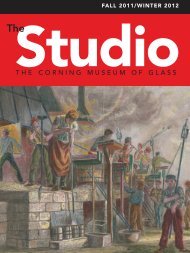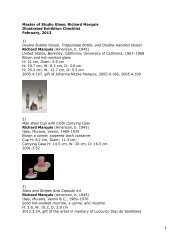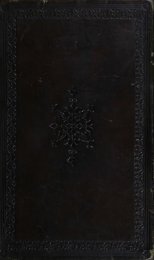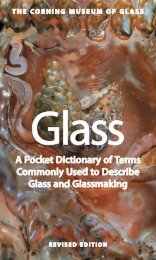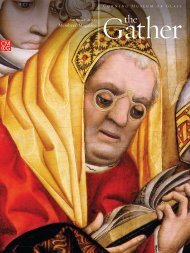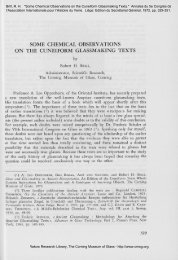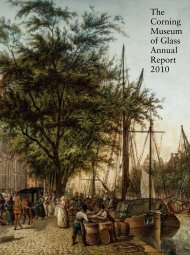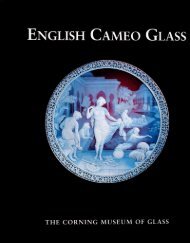Curiosities of Glassmaking - Corning Museum of Glass
Curiosities of Glassmaking - Corning Museum of Glass
Curiosities of Glassmaking - Corning Museum of Glass
You also want an ePaper? Increase the reach of your titles
YUMPU automatically turns print PDFs into web optimized ePapers that Google loves.
The result <strong>of</strong> months <strong>of</strong> digging into the <strong>Museum</strong>’s vast collections,<br />
―<strong>Curiosities</strong> <strong>of</strong> <strong><strong>Glass</strong>making</strong>‖ presents an array <strong>of</strong> unusual objects made<br />
<strong>of</strong> glass that date from antiquity to the present day. Sometimes peculiar,<br />
<strong>of</strong>ten mysterious, and generally inspired, the selections are arranged in<br />
categories and by types in a manner that is purposefully inconsistent<br />
with displays elsewhere in the <strong>Museum</strong>.<br />
Instead <strong>of</strong> documenting the chronological development <strong>of</strong> glass over the<br />
centuries, this exhibition mixes different periods, as well as various types<br />
and functions <strong>of</strong> glass. Ancient and contemporary glass may be united<br />
by a shared theme and glasses that are unrelated to each other may be<br />
shown together in a new context. Visitors are invited to observe the<br />
many unique properties <strong>of</strong> glass, such as how it is formed in nature, how<br />
it mimics other materials, how it may be used to deflect evil, how it<br />
serves medical and scientific and household purposes, and how it may<br />
portray the natural world.<br />
The title <strong>of</strong> the exhibition refers to a popular 19th-century manual,<br />
<strong>Curiosities</strong> <strong>of</strong> <strong>Glass</strong> Making. Published in London in 1849 by the wellknown<br />
glassmaker Apsley Pellatt, it revealed many secrets <strong>of</strong> ancient and<br />
modern glassmaking to an enthusiastic public.<br />
Although glass has been employed for everyday things throughout most<br />
<strong>of</strong> its history, it has also always been recognized as possessing arcane<br />
aspects. Medieval and Renaissance encyclopedias—such as the 13thcentury<br />
De Proprietatibus Rerum (On the properties <strong>of</strong> things) by<br />
Bartholomaeus Anglicus or Giambattista della Porta’s Magiae Naturalis<br />
(Natural magic), first published in 1558—recorded many special uses for<br />
glass, such as clearing eyes and kidneys, smoothing skin, counterfeiting<br />
gemstones, creating artificial fire, and effecting the spontaneous<br />
generation <strong>of</strong> animals.<br />
In this exhibition, the notion <strong>of</strong> collecting and displaying glass curiosities<br />
is inspired by the large Victorian-era museum displays <strong>of</strong> odd,<br />
exotic, and unusual objects that <strong>of</strong>ten included archeological<br />
artifacts, geological specimens, and assorted trophy animals. This type<br />
<strong>of</strong> presentation originated in the private collections <strong>of</strong> curiosities, popular<br />
from the 17th century on, that served as the foundation for many<br />
important museum collections in Europe and America today.<br />
<strong>Glass</strong> is an ordinary material that we use every day without thinking<br />
twice about it. These strange objects may inspire viewers to look for odd<br />
uses <strong>of</strong> glass in their own homes, or to find and collect their own<br />
examples <strong>of</strong> unusual objects in glass.<br />
Vessel<br />
Roman, 1st–2nd century<br />
Blown glass<br />
66.1.233<br />
1
This object is traditionally called a child’s feeder, but there is no<br />
archeological or documentary evidence to support this interpretation. It<br />
may have been used for another purpose, such as filling oil lamps.<br />
Bird Feeder<br />
Germany, about 1475–1550<br />
Blown glass<br />
77.3.56, gift <strong>of</strong> Johannes Josef Halm<br />
Fire Grenades<br />
Europe, 17th–18th century<br />
Blown glass<br />
84.3.12; 98.3.23, gift <strong>of</strong> The Wunsch Foundation Inc.<br />
Until good protective equipment was developed, firefighters could not get<br />
very close to fires. Instead, they filled grenades like these with water and<br />
tossed them into a fire to put it out.<br />
Hourglass<br />
Probably England, about 1800–1850<br />
Blown glass; wood, sand, wax<br />
68.2.3<br />
This sandglass measures about half an hour. Hourglasses were first<br />
depicted in<br />
the 14th century. They were first mentioned in a 14th-century ship’s<br />
inventory, which suggests that they were used as navigating devices.<br />
Hourglasses can measure periods <strong>of</strong> time ranging from a few minutes to<br />
an hour or more.<br />
Powder Horn<br />
John Long (American, dates unknown)<br />
United States, 1820–1840<br />
Blown glass<br />
64.4.17<br />
Bird Feeder<br />
United States, Sandwich, Massachusetts, Boston and Sandwich <strong>Glass</strong><br />
Company, 1830–1840<br />
Mold-blown glass<br />
2004.4.384<br />
Rolling Pin<br />
United States, 1870–1880<br />
Blown glass<br />
70.4.84<br />
String Holder<br />
United States, about 1890–1900<br />
Pressed glass<br />
72.4.115, gift <strong>of</strong> Preston Bassett<br />
Chain<br />
United States, 1890-1910<br />
Lampworked glass<br />
71.4.101<br />
This 8-foot long chain is decorative.<br />
Bank<br />
United States, 19th century<br />
Blown and hot-worked glass<br />
91.4.80, gift <strong>of</strong> Samuel Schwartz in memory <strong>of</strong> Esther Ipps Schwartz<br />
2
Thimbles<br />
France or possibly Bohemia, about 1900<br />
Molded glass, cut, gilded<br />
2006.3.58<br />
Stocking Darner<br />
United States, <strong>Corning</strong>, New York, Steuben Division, <strong>Corning</strong> <strong>Glass</strong><br />
Works, about 1903–1933<br />
Blown and hot-worked glass<br />
2001.4.35, gift <strong>of</strong> Gerald M. Eggert<br />
<strong>Glass</strong>-Tipped Bullets<br />
United States, <strong>Corning</strong>, New York, <strong>Corning</strong> <strong>Glass</strong> Works, 1942<br />
Molded borosilicate glass; metal casing<br />
70.4.176, .177, gifts <strong>of</strong> Otto W. Hilbert<br />
These bullets were made during World War II to address metal shortages.<br />
12-Gauge Shotgun Shell with <strong>Glass</strong> Shot<br />
United States, <strong>Corning</strong>, New York, <strong>Corning</strong> <strong>Glass</strong> Works, 1942–1943<br />
Molded borosilicate glass; brass, paper<br />
70.4.175, gift <strong>of</strong> Otto W. Hilbert<br />
Silver Streak Electric Iron and Silver Streak Iron Cover<br />
United States, <strong>Corning</strong>, New York, <strong>Corning</strong> <strong>Glass</strong> Works and Saunders<br />
Machine and Tool Corporation, designed in 1943 and made in 1946<br />
Molded borosilicate glass; aluminum, steel, and electrical components<br />
2005.4.22; 65.4.3, gift <strong>of</strong> Otto W. Hilbert<br />
The Silver Streak Pyrex iron was designed during World War II as a way<br />
to conserve metal. By the time these irons were put into production,<br />
however, the war had ended and they were no longer necessary. They<br />
were produced for only one year.<br />
Bake-A-Round Bread Tube<br />
United States, <strong>Corning</strong>, New York, <strong>Corning</strong> <strong>Glass</strong> Works, 1970s<br />
Machine-made borosilicate glass tube; metal oven rack, paper recipe<br />
2003.4.72, anonymous gift<br />
Made for a limited time in the 1970s, the Bake-A-Round was a novel use<br />
for industrial glass tubing. Surprisingly, many people still use their<br />
Bake-a-Rounds, and the original recipes, which can be hard to find, are<br />
traded on the Web.<br />
Since Roman times, glassmakers have enjoyed creating glasses in forms<br />
designed to amuse and bewilder. Trick glasses are meant to entertain,<br />
and the way that they hold or distribute liquid is usually unpredictable,<br />
which makes them perfect for drinking games.<br />
One <strong>of</strong> the more unexpected uses for glass is as flatware, which has been<br />
made since Roman times. The fact that a glass spoon can easily break<br />
suggests that it was not meant for everyday use. Although glass-handled<br />
knives, forks, and spoons were safer, they were probably reserved for use<br />
by guests.<br />
3
Spoon<br />
Probably Roman Empire, 1st century B.C.–4th century A.D.<br />
Blown and hot-worked glass<br />
54.1.105<br />
Goblet with Blue Knop<br />
Probably the Netherlands, 16th–17th century<br />
Blown glass<br />
79.3.1128, bequest <strong>of</strong> Jerome Strauss<br />
No one knows what purpose the blue bulb in this glass may have served.<br />
It has been suggested that bowls with similar blue knops may have been<br />
filled with water and small fish and then hung above sickbeds to<br />
entertain patients.<br />
Spoon<br />
Italy, 17th century<br />
Blown and hot-worked glass, gilded<br />
50.3.73<br />
Double-Walled Wineglass<br />
Italy or Spain, about 1650<br />
Blown filigrana<br />
79.3.877, gift <strong>of</strong> The Ruth Bryan Strauss Memorial Foundation<br />
Trick <strong>Glass</strong> in the Form <strong>of</strong> Bagpipes<br />
Germany, 1650–1750<br />
Optic-blown glass; applied decoration<br />
64.3.87<br />
Mug<br />
Spain, Andalusia, probably Almería, about 1700–1850<br />
Blown and cased glass; applied handle<br />
79.3.600, gift <strong>of</strong> The Ruth Bryan Strauss Memorial Foundation<br />
The transparent glass <strong>of</strong> this vessel has been cased with a darker,<br />
opaque layer <strong>of</strong> glass to make it seem as if the mug is full <strong>of</strong> beer or wine.<br />
Zwischengoldglas Beaker with Dice<br />
Bohemia, 1725<br />
Blown glass, cut, and engraved glass; gold-foil decoration, ivory dice<br />
79.3.364, gift <strong>of</strong> Jerome Strauss<br />
Knife and Fork<br />
Probably Bohemia, about 1740–1750<br />
Blown glass, gilded; metal<br />
74.3.133<br />
Knife and Fork<br />
Italy, 18th century<br />
Fused murrine, cut; metal<br />
81.3.5, 81.3.6<br />
Large Spoon<br />
United States, 1840–1870<br />
Blown lead glass, cut<br />
71.4.90<br />
Knife, Fork, and Spoon<br />
Probably Bohemia, about 1875–1900<br />
Cut glass, gilded<br />
66.3.12, gift <strong>of</strong> Mr. and Mrs. John Davis Hatch<br />
4
Trick <strong>Glass</strong><br />
France, possibly second half <strong>of</strong> the 19th century<br />
Blown glass; liquid<br />
99.3.119<br />
Knife, Fork, and Spoon<br />
Jean E. Puiforcat (French, 1897–1945)<br />
France, Paris, about 1925–1935<br />
Molded glass; silver<br />
83.3.220<br />
Bedspring Cone Cup<br />
Buster Simpson (American, b. 1942)<br />
With the assistance <strong>of</strong> Therman Statom<br />
United States, Seattle, Washington, 1983<br />
Hot-worked glass; chromed bedspring<br />
86.4.21<br />
Goblet with Stem in the Form <strong>of</strong> a Spring<br />
Elio Quarisa (Italian, b. 1936)<br />
United States, <strong>Corning</strong>, New York, 2002<br />
Blown glass<br />
2007.4.13, gift <strong>of</strong> the artist<br />
This type <strong>of</strong> stem was first made in the 1880s by the Italian glassworks<br />
Barovier & Toso.<br />
―<strong>Glass</strong>es and Pills‖ Tumbler<br />
Maria Grazia Rosin (Italian, b. 1958)<br />
Italy, Murano, 2005<br />
Blown and flameworked glass<br />
2005.3.37 C, gift <strong>of</strong> the artist and Caterina Tognon Arte Contemporanea,<br />
Venice<br />
Throughout its history, glass has been used to imitate other, usually<br />
more costly, materials. Ancient craftsmen made precious bowls <strong>of</strong> glass<br />
that looked like turquoise and rock crystal. Later, glass was used as a<br />
substitute for luxury wares made <strong>of</strong> precious and semiprecious stones<br />
(including rubies, emeralds, sapphires, agates, and marbles) and other<br />
fashionable materials, such as porcelain. Pure colorless glasses were<br />
developed to compete with rock crystal objects, and counterfeit glass<br />
gems have been popular since the Renaissance.<br />
Goblet Imitating Porcelain<br />
France, 17th century<br />
Mold-blown and hot-worked glass<br />
98.3.61, gift <strong>of</strong> The Wunsch Foundation Inc.<br />
Ice-<strong>Glass</strong> Beaker<br />
The Netherlands, 17th century<br />
Blown glass<br />
79.3.175, gift <strong>of</strong> The Ruth Bryan Strauss Memorial Foundation<br />
Ruby <strong>Glass</strong> Cup<br />
Southern Germany, about 1690–1710<br />
5
Blown glass, engraved<br />
79.3.378, bequest <strong>of</strong> Jerome Strauss<br />
Covered Mug Possibly Imitating Ceramic<br />
Probably Germany, about 1700<br />
Blown glass<br />
79.3.495, bequest <strong>of</strong> Jerome Strauss<br />
Covered Sapphire Blue Goblet<br />
England, about 1760–1780<br />
Blown glass, cut<br />
79.2.112, bequest <strong>of</strong> Jerome Strauss<br />
Cup and Saucer Possibly Imitating Snowflake Obsidian<br />
Europe, 18th century<br />
Blown glass<br />
79.3.493, bequest <strong>of</strong> Jerome Strauss<br />
Serpentine Beaker<br />
Germany, Saxony, probably Zoblitz, about 1810–1840<br />
Cut stone<br />
74.7.12<br />
This beaker entered the <strong>Museum</strong>’s collection as a glass vessel, but it was<br />
later determined to be stone.<br />
Snuff Bottle Imitating Rock Crystal<br />
Probably Scotland, about 1820–1840<br />
Blown lead glass, cut, engraved<br />
79.2.320, bequest <strong>of</strong> Jerome Strauss<br />
Beaker Imitating Agate<br />
Bohemia, about 1830–1840<br />
Blown glass, cut<br />
75.3.10, gift <strong>of</strong> Lillian Nassau<br />
―Agate‖ Beaker<br />
Southern Bohemia, Georgenthal, glassworks <strong>of</strong> the count <strong>of</strong> Buquoy,<br />
after 1834<br />
Blown glass, enameled, cut, gilded<br />
91.3.97, gift <strong>of</strong> Mrs. K. F. Landegger<br />
Jet-Black Goblet with Pattern <strong>of</strong> Arches<br />
France, Saint-Louis, Compagnie des Cristalleries de Saint-Louis, 1840<br />
Pressed glass<br />
58.3.193<br />
Marbled Wine or Dessert <strong>Glass</strong><br />
Italy, 1850–1875<br />
Blown glass<br />
79.3.1001, gift <strong>of</strong> The Ruth Bryan Strauss Memorial Foundation<br />
―Chalcedony‖ Beaker<br />
Italy, 19th century<br />
Blown glass<br />
74.3.161, gift <strong>of</strong> Jerome Strauss<br />
―Chalcedony‖ Vase<br />
Italy, Venice, 19th century<br />
Blown and hot-worked glass<br />
71.3.161, gift <strong>of</strong> Mr. and Mrs. Gillett Welles Sr.<br />
6
Vase Imitating Jade<br />
China, 19th century<br />
Blown glass<br />
56.6.5, gift <strong>of</strong> Mrs. E. C. Chadbourne<br />
Cup Imitating Turquoise<br />
China, 1912–1949<br />
Blown glass<br />
56.6.8, gift <strong>of</strong> Mrs. E. C. Chadbourne<br />
<strong>Glass</strong> Shoe<br />
Frederick Carder (American, born in England, 1863–1963)<br />
United States, <strong>Corning</strong>, New York, Steuben Division, <strong>Corning</strong> <strong>Glass</strong><br />
Works, 1925<br />
Mold-blown glass<br />
66.4.74<br />
This glass slipper was designed for a movie production <strong>of</strong> Cinderella, but<br />
the film was never completed.<br />
―Leather‖ Glove<br />
Fulvio Bianconi (Italian, 1915–1996)<br />
Italy, Murano, Venini, 1948<br />
Optic-blown and hot-worked glass; gold-foil decoration<br />
L.238.3.2000, lent by The Steinberg Foundation<br />
Scientists tell us that glass is a state <strong>of</strong> matter rather than a single<br />
material. It is formed when a molten material cools so rapidly that there<br />
is not enough time for the material’s crystalline structure to re-form.<br />
Obsidian, for example, is rock in a glassy state, just as hard candy is<br />
sugar in a glassy state. In nature, glasses are formed when sand and<br />
rocks are heated to high temperatures and then cooled rapidly.<br />
Chunk <strong>of</strong> Obsidian<br />
Collected in the United States<br />
Volcanic glass; metallic inclusions<br />
62.7.3, gift <strong>of</strong> George D. MacBeth<br />
Obsidian is formed when molten volcanic rock from the interior <strong>of</strong> the<br />
earth (lava) cools rapidly.<br />
Chunk <strong>of</strong> Obsidian<br />
Collected in California<br />
Volcanic glass<br />
63.7.12, gift <strong>of</strong> Fred P. Bentley<br />
Spearheads<br />
United States, about 1000–1500<br />
Hand-chipped volcanic glass<br />
62.7.1, gift <strong>of</strong> The Santa Barbara <strong>Museum</strong> <strong>of</strong> Natural History<br />
<strong>Glass</strong>y materials have a shiny surface and they show curved, conchoidal<br />
(shell-like) fractures. The edges <strong>of</strong> these spearheads display this<br />
characteristic type <strong>of</strong> fracture.<br />
Obsidian Knife<br />
Possibly Mexico, 1200–1521<br />
Hand-chipped volcanic glass<br />
7
65.1.19, gift <strong>of</strong> J. J. Klejman<br />
Tektites<br />
Collected in Vietnam<br />
Nonvolcanic terrestrial or extraterrestrial glass<br />
59.7.4; 96.7.4, gift <strong>of</strong> Christopher Sheppard; 2000.7.16, .18, .24, .27,<br />
.32, .38, .48, gift <strong>of</strong> Darryl S. Futrell<br />
Like volcanic glass (obsidian), which is formed when lava cools rapidly,<br />
tektites are created when rocks and soil are melted by a meteoritic<br />
impact and then rapidly cooled. Tektites are formed at a much higher<br />
temperature than volcanic glass and under tremendous pressure. The<br />
meteoritic impacts, which occurred millions <strong>of</strong> years ago, literally melted<br />
the rock <strong>of</strong> the meteor and the surrounding terrestrial rock, creating the<br />
spherical forms, comma shapes, drips, and splashes characteristic <strong>of</strong><br />
tektites.<br />
Large Tektite<br />
Collected in Vietnam<br />
Nonvolcanic terrestrial or extraterrestrial glass<br />
2000.7.3, gift <strong>of</strong> Darryl S. Futrell<br />
Tektites occur in specific geographic areas, which are called tektite<br />
strewn-fields. Fields that have yielded many tektites are located in<br />
Vietnam (also called Indochina), the Ivory Coast <strong>of</strong> west Africa, the<br />
Philippines, the Czech Republic (where meteoritic moldavites are found),<br />
Australia, and in the United States (Georgia and Texas).<br />
Spherical Tektites<br />
Collected in Texas and elsewhere<br />
Nonvolcanic terrestrial or extraterrestrial glass<br />
2000.7.4–.6, gift <strong>of</strong> Darryl S. Futrell<br />
Libyan Desert <strong>Glass</strong><br />
Sahara, Egypt or Libya, Great Sand Sea, possibly collected in Libya in<br />
1934<br />
Nonvolcanic terrestrial or extraterrestrial glass<br />
2000.7.1, gift <strong>of</strong> Darryl S. Futrell<br />
Libyan desert glass, which is almost pure silica, ranges from small flakes<br />
and nuggets to heavy chunks, such as this impressively large example.<br />
It is not known what happened millions <strong>of</strong> years ago to create this glass,<br />
which exists, as far as we know, only in the remote desert region <strong>of</strong><br />
western Egypt and eastern Libya. It is believed to have either resulted<br />
from a meteoritic impact or from a comet exploding in the earth’s<br />
atmosphere. The composition <strong>of</strong> Libyan desert glass is quite different<br />
from that <strong>of</strong> other glass <strong>of</strong> meteoritic origin, such as tektites. Lunar soils<br />
also have a high silica content and are glassy.<br />
Fulgurites<br />
Collected in Michigan and Arizona<br />
<strong>Glass</strong><br />
64.7.9, gift <strong>of</strong> Harvey Franz; 63.7.30, gift <strong>of</strong> Dr. Monroe McIver<br />
Fulgurites, sometimes called petrified lightning, are found everywhere.<br />
They are formed when lightning strikes sand dunes. Fulgurites vary in<br />
length from a few inches to several feet, and they break easily. The<br />
longest recorded example measures 17 feet.<br />
<strong>Glass</strong> Sponge<br />
Probably collected in the 19th century<br />
<strong>Glass</strong>; wood and glass display dome<br />
2005.7.26<br />
Sponges are among the oldest known multicellular animals. The<br />
spicules (needlelike structures) that form the sponge's skeleton are made<br />
8
<strong>of</strong> different materials such as silica, carbonates, and protein fibers.<br />
<strong>Glass</strong> sponges, which live in the deep ocean, have skeletons made <strong>of</strong><br />
silica spicules. This skeleton <strong>of</strong> the sponge known as Euplectella is a<br />
lattice <strong>of</strong> silica. A scientific study <strong>of</strong> its substructure and refractive<br />
properties found that the sponge’s silica spicules transmit light in a<br />
similar way to the optical fibers used in telecommunications.<br />
Trinitite<br />
United States, White Sands, New Mexico, Trinity test site, 1945<br />
<strong>Glass</strong><br />
2006.4.237, gift in memory <strong>of</strong> Stephen P. Tooney<br />
These samples were collected at the Trinity test site <strong>of</strong> what is now the<br />
White Sands Missile Range in White Sands, New Mexico. Trinitite was<br />
unintentionally created by the United States Army on July 16, 1945,<br />
during the testing <strong>of</strong> the Trinity atomic bomb. The trinitite appears to<br />
have formed as sand was sucked up into the nuclear fireball, falling back<br />
to the ground in a rain <strong>of</strong> molten glass. These specimens are no longer<br />
radioactive.<br />
Miranda VIII<br />
John Leighton (American, b. 1948)<br />
United States, Oakland, California, 1991<br />
Cast glass; wire<br />
2004.4.67, gift <strong>of</strong> the artist in memory <strong>of</strong> his father, Jasper L. Leighton<br />
Although this sculpture was made by an artist and not by nature, the<br />
ancient–looking, crusty surface is reminiscent <strong>of</strong> the glass formed by the<br />
impacts <strong>of</strong> meteorites.<br />
With the exception <strong>of</strong> the Klein Bottle, the glass in this group has not<br />
been annealed (allowed to cool slowly). Because <strong>of</strong> the internal stresses<br />
that are created when the surface <strong>of</strong> the glass cools faster than its<br />
interior, unannealed glass can explode at any time. These items are<br />
displayed inside their own case, where they can do no harm if they selfdestruct<br />
during the exhibition.<br />
Klein Bottle<br />
United States, Oakland, California, Acme Klein Bottle Company, 2006<br />
Flameworked borosilicate glass<br />
2007.4.14<br />
The Klein Bottle is not meant to be functional but to illustrate a<br />
mathematical principle. Its surface is continuous, which means that the<br />
vessel does not have a conventional interior and exterior. The Acme<br />
Klein Bottle company’s Web site states that ―in 1882, Felix Klein<br />
imagined sewing two Möbius Loops together to create a single-sided<br />
bottle with no boundary. Its inside is its outside. It contains itself.‖<br />
Christian Felix Klein (1849–1925) was a German mathematician best<br />
known for his reorganization <strong>of</strong> the study <strong>of</strong> geometry in the late 19th<br />
century.<br />
Prince Rupert’s Drops<br />
Prince Rupert’s drops are created by dripping hot glass into cold water,<br />
which forms a solid tadpole-shaped droplet with a long, thin tail.<br />
Because the water rapidly cools the outside <strong>of</strong> the droplet while the<br />
interior remains hot, stresses are created inside the glass. Although a<br />
Prince Rupert’s drop can withstand blows from a blunt instrument on its<br />
9
ulbous end, it will explode if the tail is broken or even slightly damaged.<br />
The drop is said to have been discovered in the mid 17th-century by<br />
Rupert, count palatine <strong>of</strong> the Rhine and duke <strong>of</strong> Bavaria, commonly<br />
known as Prince Rupert <strong>of</strong> the Rhine (1619–1682).<br />
Bologna Vial<br />
A Bologna vial is an unannealed glass vial <strong>of</strong> any form and <strong>of</strong> any kind <strong>of</strong><br />
glass that is much thicker at the bottom than at the top. This glass can<br />
be hit with a blunt instrument without breaking, but if the inside or<br />
outside surface is scratched, the stresses inside the glass cause the vial<br />
to explode.<br />
10
Easy to clean and sterilize, glass is a preferred material for all kinds <strong>of</strong><br />
medical purposes. One <strong>of</strong> the more quaint—and today bizarre—uses <strong>of</strong><br />
glass in medicine is related to the practice <strong>of</strong> bloodletting, or phlebotomy.<br />
Cupping <strong>Glass</strong><br />
Possibly Islamic, 8th–11th century<br />
Blown glass<br />
65.1.31<br />
Mortar (Fragment) and Pestle<br />
Europe, 17th century<br />
Blown and hot-worked glass<br />
2006.3.78, gift <strong>of</strong> The Wunsch Foundation Inc.<br />
This mortar and pestle were found in Amsterdam.<br />
Woman’s Urinal<br />
Northern Europe, 18th century<br />
Blown glass<br />
69.3.13<br />
Five Bleeding Instruments in a Travel Case<br />
England, about 1810–1830<br />
Blown glass; wood, brass, steel, chamois, velvet<br />
79.2.2<br />
This set includes a brass scarificator, used to make multiple cuts in a<br />
patient’s skin, and several cupping glasses. The blood removed from the<br />
body during a bloodletting procedure could be caught in shallow bowls or<br />
in small glass cups. Heated air created a vacuum inside the cups, which<br />
caused the blood to flow into them. This practice was called cupping.<br />
Cupping <strong>Glass</strong><br />
United States or possibly England, 19th century<br />
Blown glass<br />
76.4.4, gift <strong>of</strong> Alfred Wolkenberg<br />
Optical Model <strong>of</strong> the Eye<br />
Probably France, 19th century<br />
Optical glass; brass, lacquered metal (probably copper)<br />
2004.3.40<br />
Case Illustrating the Making <strong>of</strong> Prosthetic <strong>Glass</strong> Eyes<br />
United States, Needham, Massachusetts, Tamworth Associates,<br />
1929–1940<br />
Lampworked glass; display box<br />
52.4.58<br />
This case was created for display in a doctor’s <strong>of</strong>fice or for use by a<br />
traveling salesman. It shows the steps involved in making glass eyes,<br />
from the original rods to the finished products. Each artificial eye was<br />
made for a specific patient (to match his or her remaining eye), and the<br />
coloring was carefully applied. During the Renaissance, European<br />
11
lampworkers produced glass eyes by heating and manipulating hollow<br />
glass rods over the flame <strong>of</strong> a lamp. Itinerant craftsmen brought the<br />
technique to America in the 19th century, and by 1900, there were<br />
makers <strong>of</strong> glass eyes in all <strong>of</strong> the major Eastern cities. Today, most<br />
artificial eyes are made <strong>of</strong> plastic.<br />
Prosthetic Eyes<br />
Japan, Amagasaki, Iwaki <strong>Glass</strong> Company, 1926<br />
Flameworked glass<br />
61.6.41, gift <strong>of</strong> Kuranosuke Iwaki<br />
Prosthetic Eye<br />
United States, Needham, Massachusetts, Tamworth Associates,<br />
1929–1940<br />
Flameworked glass<br />
52.4.58<br />
Ear Level<br />
Jocelyne Prince (Canadian, b. 1963)<br />
United States, Providence, Rhode Island, 1994<br />
Blown glass; steel, motor oil, cotton batting, metal; assembled<br />
98.4.18<br />
This eccentric object was inspired by medical models <strong>of</strong> the ear and other<br />
parts <strong>of</strong> the body.<br />
Among the earliest objects made in glass are eye beads, which date to the<br />
third millennium B.C. Like modern eye beads, they are meant to deflect<br />
the evil eye, which is believed to cause sickness in people and in animals.<br />
The evil eye is caused by envy and jealousy, and it may be intentionally<br />
or unintentionally given. An eye bead <strong>of</strong>fers the wearer protection from<br />
the evil eye, as well as general protection against negative energy and ill<br />
will.<br />
Eye Beads<br />
China, 1122–221 B.C.<br />
Hot-worked glass<br />
51.6.556, 68.6.3<br />
Eye Beads<br />
Attributed to Iran, 10th century B.C.<br />
Hot-worked glass<br />
74.1.4<br />
Eye Bead<br />
Probably Egypt or possibly Near East, 8th–4th century B.C.<br />
Core-formed glass<br />
54.1.144<br />
Eye Bead<br />
Eastern Mediterranean, probably Carthage or possibly Egypt,<br />
6th–3rd century B.C.<br />
Core-formed glass, trail-decorated<br />
54.1.23, gift <strong>of</strong> Fahim Kouchakji<br />
Eye Beads and Pendant<br />
12
Eastern Mediterranean or Carthage, 600–250 B.C.<br />
Core-formed glass, trail-decorated<br />
54.1.140, .143<br />
Eye Beads<br />
China, 4th century B.C.<br />
Hot-worked glass<br />
51.6.554, .572<br />
Wedjet-Eye Ring<br />
Egypt, 3rd–1st century B.C.<br />
Hot-worked glass or glassy faience<br />
76.1.95, gift <strong>of</strong> Carl Berkowitz and Derek Content<br />
The wedjet eye is the best known <strong>of</strong> the Egyptian protective amulets, and<br />
it was believed to have strong healing powers. It represents the eye <strong>of</strong><br />
the falcon-headed god Horus, and it was worn in life and in death.<br />
Eye Bead<br />
Roman Empire, 1st century B.C.–1st century A.D.<br />
Fused and hot-worked mosaic glass<br />
54.1.152<br />
Magatama Amulets<br />
Japan, Nara period, 710–794<br />
Molded glass, cut<br />
61.6.1, .4, .58; 71.6.14, gift <strong>of</strong> Dorothy Blair<br />
Magatama are traditional curved beads that are said to represent the<br />
human spirit, and the wearer is believed to have the special protection <strong>of</strong><br />
the gods. In modern Japan, the form <strong>of</strong> the magatama is still used as a<br />
visual representation <strong>of</strong> the human spirit.<br />
Eye Beads<br />
Italy, 19th century<br />
Fused and hot-worked mosaic glass<br />
73.3.48, .156<br />
Eye Beads<br />
Possibly Middle East, 19th or 20th century<br />
Hot-worked glass<br />
70.3.240<br />
Witch Ball<br />
United States, about 1806–1853<br />
Blown glass<br />
50.4.469<br />
The evil eye is not the only source <strong>of</strong> ambient negativity and ill will.<br />
―Witches,‖ for example, can include anyone who actively wishes<br />
misfortune or sickness on others, or who causes others to suffer. The<br />
witch ball is believed to be the ancestor <strong>of</strong> the Christmas tree ornament,<br />
which was originally meant to protect gifts from outsiders who might<br />
covet them. In the United States, witch balls were traditionally filled with<br />
colorful bits <strong>of</strong> paper and string to confuse and repel witches who might<br />
be lurking around the house.<br />
Witch Ball<br />
United States, Midwest, about 1816–1830<br />
Optic-blown glass<br />
50.4.103<br />
Witch Ball<br />
United States, 1820–1860<br />
13
Blown glass<br />
62.4.37<br />
Witch Ball<br />
United States, 19th century<br />
Optic-blown glass<br />
50.4.287<br />
Eye Beads<br />
Turkey, Istanbul, about 1968<br />
Hot-worked glass<br />
75.3.37<br />
In addition to beads with the symbol <strong>of</strong> the eye, any brilliant blue bead is<br />
effective in dispelling the evil eye.<br />
Eye Beads<br />
Turkey, Izmir vicinity, about 1991<br />
Hot-worked glass<br />
91.3.105, gift <strong>of</strong> M. Vest and T. Sode<br />
Maşallah Bird on Globe Holding An Eye Bead<br />
Turkey, Eskişehir, Eskişehir Prison, about 1997<br />
<strong>Glass</strong> beads, heart-shaped glass evil eye bead; plastic beads and spacers,<br />
nylon thread, cardboard<br />
2007.3.62, gift <strong>of</strong> Stephen P. Koob<br />
Maşallah—a Turkish word adapted from the Arabic ma sha’ Allah (―what<br />
wonders has God willed‖)—is an expression <strong>of</strong> thanks for a good omen.<br />
The maşallah birds, which are made by prison inmates, protect drivers.<br />
Witch Pot<br />
Laura Donefer (Canadian, b. 1955)<br />
Canada, Harrowsmith, Ontario, 1999<br />
Blown glass, beads; mixed media<br />
2000.4.32, gift <strong>of</strong> the artist<br />
Adorned with antlers and stocked with dirt, bones, and other natural<br />
materials, this vessel creates its own energy and symbolic power.<br />
Passion Bottle<br />
Attributed to Alexandre Soudart (French, about 1850–1914)<br />
France, Sars-Poteries, second half <strong>of</strong> the 19th century<br />
Blown and lampworked glass; water<br />
77.3.25, gift <strong>of</strong> Countess J. de Vogüé<br />
This bottle is based on Florentine liquid-in-glass thermometers, which<br />
make use <strong>of</strong> a physical principle first observed by Galileo. As the<br />
temperature <strong>of</strong> the water changes, its density also changes, forcing the<br />
glass floaters to descend or ascend. All <strong>of</strong> the lampworked figurines are<br />
associated with the symbolism <strong>of</strong> the Passion <strong>of</strong> Christ.<br />
Geissler Tube and Stand<br />
Probably Germany or England, 1870–1915<br />
Lampworked glass; wood stand<br />
97.3.24<br />
The German physicist Heinrich Geissler (1814–1879) is best known for<br />
his invention <strong>of</strong> sealed glass tubes (called Geissler tubes) in 1857. He<br />
created a bluish light by using an electrode to activate the gas sealed<br />
inside the tube. The Geissler tube was the precursor <strong>of</strong> such everyday<br />
14
necessities as fluorescent lamps, neon signs, and television cathode-ray<br />
tubes.<br />
Four Hydrometers in a Case<br />
France, Paris, Salleron Dujardin, 1903<br />
Lampworked glass; mercury, travel case<br />
71.3.174, gift <strong>of</strong> the Taylor Instrument Company<br />
A hydrometer is an instrument used for determining the specific gravity<br />
<strong>of</strong> liquids. These glass examples consist <strong>of</strong> a cylindrical stem and a bulb<br />
weighted with mercury to make it float upright. The liquid to be tested is<br />
poured into a tall jar, and the hydrometer is gently lowered into the<br />
liquid until it floats freely. Hydrometers usually contain a paper scale<br />
inside the stem so that the specific gravity (where the liquid touches the<br />
stem) can be determined.<br />
Bubble Holder<br />
Peter Ivy (American, b. 1969)<br />
United States, Providence, Rhode Island, 1995<br />
Blown and hot-worked glass; soap bubble; assembled<br />
98.4.22<br />
Peter Ivy constructed this elaborate holder for the most ephemeral <strong>of</strong><br />
objects: a soap bubble. The soap bubble lasts only for a few hours at<br />
most before it needs to be remade.<br />
Meitnerium IV<br />
Richard Craig Meitner (American, b. 1949)<br />
The Netherlands, Amsterdam, 1997<br />
Blown glass; quartz, wood, gilding<br />
2003.3.4, gift <strong>of</strong> Barry Friedman Ltd., New York<br />
This piece was inspired by the strange Victorian pseudo-scientific<br />
instruments<br />
used to measure different phenomena. Richard Meitner presents a<br />
sample <strong>of</strong> quartz, or rock crystal, which is symbolic <strong>of</strong> magnetic energy<br />
and purity.<br />
<strong>Glass</strong> has been used throughout its history to store and protect valuable<br />
specimens, keepsakes, and even human remains.<br />
Reliquary Beaker (Krautstrunk)<br />
Southern Germany or Austria, Tyrol, late 15th–early 16th century<br />
Blown glass; wax, bone, fabric<br />
70.3.23<br />
This object was made as a functional drinking vessel that was later<br />
reused as a reliquary. Drinking vessels, including goblets, have been<br />
found buried in the walls <strong>of</strong> churches, with their sacred contents—<strong>of</strong>ten<br />
physical remains—sealed inside. We do not know exactly what is inside<br />
this reliquary and we do not plan to open it.<br />
Reliquary for Saint Margaret<br />
Probably Spain, about 1578<br />
Blown glass; brass mount<br />
61.3.110<br />
The reliquary is inscribed, in Latin, ―Hoc do Antonius Maria Tosilerius<br />
donavit Divae Margarite 1578‖ (I, A. M. Tosilerius, give this to Saint<br />
Margaret, 1578).<br />
15
Specimen <strong>Glass</strong><br />
United States, possibly Philadelphia, Pennsylvania, about 1820–1840<br />
Blown glass; painted metal lid<br />
2005.4.32, gift <strong>of</strong> Harley N. Trice<br />
The silver tag attached with a string to the stem <strong>of</strong> this glass bears the<br />
words ―The Wistar/1465/Institute.‖ Inside the glass is a fragment,<br />
possibly <strong>of</strong> stone. The Wistar Institute is a biomedical research facility in<br />
Philadelphia.<br />
Funny Jars<br />
Nancy Jamison Adams (American, 1852–1932)<br />
Grace Steen Norman-Wilcox (American, 1898–1995)<br />
United States, Ohio and California, about 1860–1880 and about 1935–<br />
1955<br />
Found blown glass bottles; lacquered tin lids, mixed media<br />
85.4.28, .29, gift <strong>of</strong> Grace Norman-Wilcox<br />
These keepsake jars were made by Adams and her granddaughter.<br />
Reliquary glasses can preserve human remains or other sacred contents,<br />
or they can hold cherished memories.<br />
Copy <strong>of</strong> a Patent for Preserving the Dead in <strong>Glass</strong><br />
Patent No. 748,284, awarded to Joseph Karwowski, Herkimer, New York<br />
by the U.S. Patent and Trademark Office, dated December 29, 1903.<br />
The awarding <strong>of</strong> this patent is truly a mystery because the method<br />
described by Karwowski cannot work: the body would be burned by the<br />
molten glass used to encase it. The inventor wrote that this patent ―has<br />
for its object the provision <strong>of</strong> a means whereby a corpse may be<br />
hermetically incased within a block <strong>of</strong> transparent glass . . . so that it will<br />
be prevented from decay and will at all times present a life-like<br />
appearance.‖<br />
Illustration <strong>of</strong> a <strong>Glass</strong> Casket from a Trade Catalog<br />
United States, Muskogee, Oklahoma, DeCamp Consolidated <strong>Glass</strong><br />
Casket Company, 1929<br />
<strong>Glass</strong> c<strong>of</strong>fins, which were cushioned with yards <strong>of</strong> fabric, were not meant<br />
to display the body but rather to hygienically protect it from the<br />
elements.<br />
Skull<br />
Raul Goldoni (Italian, b. 1919)<br />
Italy, Murano, 1970<br />
Hot-sculpted glass<br />
81.3.37<br />
Uranium glass (also called Vaseline glass) is characterized by intense<br />
yellow to green colors that fluoresce bright green under ultraviolet light.<br />
It is made by adding uranium to the glass batch. Although most<br />
uranium glass will register as radioactive (as can be seen on the Geiger<br />
counter placed among these glasses), the amount <strong>of</strong> radiation is<br />
negligible, and the glass is considered safe to handle. The Bohemian<br />
glassmaker Josef Riedel is <strong>of</strong>ten credited with the first production <strong>of</strong><br />
uranium glass in 1830. Although it was known as a colorant for glass in<br />
England as early as 1817, the first documented example <strong>of</strong> British<br />
16
uranium glass dates to 1837. By 1850, uranium glass was being<br />
produced by European and American manufacturers.<br />
Bottle<br />
Bohemia, about 1840–1850<br />
Blown uranium glass, cut<br />
54.3.50, gift <strong>of</strong> Ellen D. Sharpe<br />
Covered Sugar Bowl<br />
England, about 1840–1860<br />
Pressed uranium glass<br />
66.2.3, gift <strong>of</strong> Mrs. Alan Cornwell<br />
Wineglass<br />
Probably Bohemia, about 1850<br />
Blown uranium glass, cut<br />
79.3.916, gift <strong>of</strong> The Ruth Bryan Strauss Memorial Foundation<br />
Pocket Beaker<br />
Bohemia, 1850–1875<br />
Mold-blown uranium glass, cut, engraved<br />
70.3.320, gift <strong>of</strong> Jerome Strauss<br />
The flattened shape <strong>of</strong> the beaker enabled it to fit comfortably inside a<br />
pocket.<br />
Beaker<br />
Austria, Vienna, Fischer, Furchtegott Leberecht, about 1910–1920<br />
Mold-blown uranium glass, enameled, cut, gilded<br />
95.3.33<br />
Pair <strong>of</strong> ―Vintage‖ Pattern Candlesticks<br />
United States, 1920–1930<br />
Blown uranium glass, engraved<br />
96.4.45, gift <strong>of</strong> Edward R. Meddaugh<br />
Salt and Pepper Shakers<br />
United States, Jeannette, Pennsylvania, Jeannette <strong>Glass</strong> Company,<br />
about 1928–1932<br />
Pressed uranium glass; metal lids<br />
98.4.147, gift <strong>of</strong> the Long Island Depression <strong>Glass</strong> Society, Ltd.<br />
Beads<br />
Possibly Czechoslovakia, 1930s<br />
Molded uranium glass<br />
91.3.233, gift <strong>of</strong> Mrs. Arline B. Oliphant in name <strong>of</strong> Naisha Butler<br />
Frosted Radio Light<br />
Paul Seide (American, b. 1949)<br />
United States, New York, New York, 1986<br />
Blown, cased, hot-worked glass; neon, mercury vapor, radio transmitter<br />
87.4.41, gift <strong>of</strong> Mike Belkin<br />
Paul Seide is one <strong>of</strong> the few pioneering glass artists who began to explore<br />
neon in the 1970s. Although we see neon everywhere in the form <strong>of</strong><br />
building and product signs, Seide and others wanted to use it as a<br />
medium for sculpture and installations. Inspired by the light work <strong>of</strong><br />
17
such well-known artists as Dan Flavin and Bruce Nauman, glass artists<br />
developed new ways in which neon could be integrated into art. As is<br />
typical <strong>of</strong> Seide’s work, the colors <strong>of</strong> this sculpture change when it is<br />
touched.<br />
Silvered glass, also called mercury glass, is double-walled glassware with<br />
a silver coating inside its walls. Dichroic (two-color) glass changes color<br />
in different kinds <strong>of</strong> lighting. Many 19th-century glass manufacturers<br />
attempted to produce silvered glass by using tin, lead, bismuth, mercury,<br />
and various compounds. Early examples employed mercury, based on<br />
the techniques used for silvering mirrors, but these were unsuccessful.<br />
In 1849, the London retailers Hale Thomson and Edward Varnish were<br />
granted a patent for their method <strong>of</strong> making silvered glass.<br />
Footed Tumbler<br />
England, London, James Powell & Sons (Whitefriars) Ltd. for Hale<br />
Thomson,<br />
about 1850–1860<br />
Mold-blown glass, silvered, engraved<br />
66.2.9, gift <strong>of</strong> Mr. Jerome Strauss<br />
Silvered glass was commonly made with solutions <strong>of</strong> silver nitrate<br />
combined with some form <strong>of</strong> glucose. The silvering liquid was poured<br />
into the space between the walls <strong>of</strong> the glass vessel through a hole in the<br />
bottom, and it adhered to the glass.<br />
Cased Goblet<br />
England, London, James Powell & Sons (Whitefriars) Ltd. for E. Varnish<br />
and Company, about 1850–1860<br />
Blown and cased glass, silvered, cut<br />
79.2.169, bequest <strong>of</strong> Jerome Strauss<br />
In this goblet, the outer layer <strong>of</strong> blue glass has been cut away to reveal<br />
the silvered glass beneath.<br />
Pair <strong>of</strong> Cased Vases<br />
England, London, James Powell & Sons (Whitefriars) Ltd. for E. Varnish<br />
and Company, about 1850–1860<br />
Blown and cased glass, silvered, cut<br />
2006.2.6, gift <strong>of</strong> Freeman T. Freeman<br />
Cased Vase<br />
England, London, James Powell & Sons (Whitefriars) Ltd. for E. Varnish<br />
and Company, about 1850–1860<br />
Blown and cased glass, silvered<br />
60.2.43<br />
Mug<br />
Possibly Austria, about 1850–1870<br />
Mold-blown glass, silvered<br />
79.3.826, gift <strong>of</strong> The Ruth Bryan Strauss Memorial Foundation<br />
Cup and Saucer<br />
Bohemia, mid-19th century<br />
Mold-blown glass, silvered, cut, painted<br />
76.3.9<br />
18
Vase with Cartouche <strong>of</strong> Boy in Oriental Costume<br />
Hugo Wolf (Bohemian, dates unknown)<br />
Bohemia, Iglau, about 1875–1895<br />
Blown glass, silvered, enameled<br />
2002.3.12<br />
―Alexandrite‖ Vase<br />
Heinrich Hussman (German, 1897–1981)<br />
Czechoslovakia, Karlovy Vary, Ludwig Moser & Söhne, about 1928–1930<br />
Mold-blown neodymium glass, cut<br />
2006.3.2<br />
Hussman invented this type <strong>of</strong> dichroic glass, which he called<br />
Alexandrite. The glass changes from pinkish purple in incandescent<br />
light to teal blue in fluorescent light. The color is made by adding the<br />
rare-earth element neodymium to the glass batch.<br />
19
Materials such as clay, wood, stone, and fiber, which can be collected in<br />
nature and easily fashioned into objects, may seem more suited than<br />
glass to depictions <strong>of</strong> the natural world. Yet glass is a versatile material<br />
than can assume almost any color and imitate almost any surface.<br />
Beaker with Quail<br />
England, London, workshop <strong>of</strong> James Giles, about 1760–1770<br />
Blown glass, gilt decoration<br />
64.2.3<br />
Diorama with Nuns in a Grotto<br />
France, Nevers, 18th–19th century<br />
Flameworked glass; cardboard, paper, wax<br />
61.3.12, gift <strong>of</strong> Mrs. Howell Howard<br />
Making complex scenes (most <strong>of</strong>ten <strong>of</strong> religious subjects) from glass and<br />
other materials was a popular pastime for cloistered nuns.<br />
Goblet with Spiders<br />
Bohemia, about 1840–1860<br />
Blown glass, stained, engraved<br />
91.3.43, gift <strong>of</strong> Mrs. Jerome Strauss<br />
Landscape <strong>Glass</strong><br />
United States or possibly England, about 1845–1865<br />
Cut glass lenses; tortoiseshell holder<br />
74.4.98<br />
Colored lenses and reducing glasses were popular for viewing nature<br />
from the mid-18th to late 19th centuries. They were called ―Claude<br />
Lorrain‖ glasses, after the 17th-century French landscape painter’s<br />
atmospheric and complex multi-hued images. Period advertisements<br />
describe the landscape glass as ―pleasing and useful for viewing clouds,<br />
eclipses, and landscapes.‖<br />
Tooth Necklace<br />
Northern or central Europe, probably 1850–1900<br />
Molded glass; animal teeth, shell, fiber<br />
62.3.23<br />
Pair <strong>of</strong> ―Devil’s Fire‖ Paperweights<br />
United States, about 1880–1900<br />
Blown and cased glass, cut<br />
78.4.170, .171, gifts <strong>of</strong> The Honorable and Mrs. Amory Houghton<br />
An unusual decorative theme for paper-weights is the so-called devil’s<br />
fire, as<br />
it is known in New Jersey, which is related to the natural phenomena <strong>of</strong><br />
foxfire and the will-o’-the-wisp. All <strong>of</strong> these phenomena refer to the s<strong>of</strong>t,<br />
glowing lights that are <strong>of</strong>ten seen in forests and marshes at night. These<br />
lights are thought to be created by bioluminescent fungi.<br />
Sample <strong>of</strong> Fiberglass Hair<br />
United States, <strong>Corning</strong> <strong>Glass</strong> Works, <strong>Corning</strong>, New York, 1936<br />
Fiberglass; string<br />
2002.4.20, gift <strong>of</strong> Pat and Tom James<br />
Polyvitrified Huffian<br />
20
Hugh Wesler (American, b. 1947)<br />
United States, Madison, Wisconsin, 1979<br />
Blown glass; display cabinet<br />
79.4.115, gift <strong>of</strong> Mr. and Mrs. George B. Wesler<br />
This is a careful fabrication <strong>of</strong> a fictional animal skull.<br />
Crustacean<br />
Alfredo Barbini (Italian, 1912–2007)<br />
Italy, Murano, about 1985<br />
Hot-sculpted glass<br />
86.3.10<br />
Insects<br />
Vittorio Costantini (Italian, b. 1944)<br />
Italy, Venice, about 1985–1989<br />
Flameworked glass<br />
86.3.66, 89.3.15, 91.3.20, 89.3.25, gift <strong>of</strong> Susanne K. Frantz<br />
Scallop Shell<br />
United States, <strong>Corning</strong>, New York, Steuben, 1989<br />
Molded glass<br />
2004.4.329, The Robert E. and Carol J. Nelson Collection<br />
Terebra Shell<br />
Paul Schulze (American, b. 1934)<br />
United States, <strong>Corning</strong>, New York, Steuben, 1991<br />
Molded glass<br />
2004.4.333, The Robert E. and Carol J. Nelson Collection<br />
Segmentation<br />
Michael Scheiner (American, b. 1956)<br />
United States, Providence, Rhode Island, 1991<br />
Mold-blown glass; fiberglass, epoxy resin<br />
92.4.109<br />
The hornlike form <strong>of</strong> this sculpture inspired its inclusion in this<br />
exhibition. Treasures <strong>of</strong> the traditional cabinet <strong>of</strong> curiosities usually<br />
included horns and tusks <strong>of</strong> exotic and legendary animals.<br />
Tail<br />
Kiki Smith (American, born in Germany, 1954)<br />
With the assistance <strong>of</strong> Michael Scheiner<br />
United States, New York, New York, 1997<br />
Cast glass<br />
2004.4.71<br />
In her art work, Kiki Smith explores the human body—its skeletal<br />
structure and especially its organs and fluids—with the detached eye <strong>of</strong><br />
the scientist and the poetic mind <strong>of</strong> the artist. This is a depiction <strong>of</strong> that<br />
strange and fascinating anatomical part which is the human tailbone.<br />
The Murmur <strong>of</strong> the Bees<br />
Michael Rogers (American, b. 1955)<br />
United States, Rochester, New York, 2006<br />
Engraved and painted antique wood and glass display case; embroidered<br />
cotton<br />
L.1.4.2007, lent by the artist<br />
Throughout his career, Michael Rogers has admired and been inspired by<br />
the life work <strong>of</strong> Leopold and Rudolf Blaschka, the Bohemian father-andson<br />
lampworkers who used glass to create thousands <strong>of</strong> scientificallyaccurate<br />
models <strong>of</strong> botanical specimens and invertebrates. After<br />
acquiring a display case that was once used in the exhibition <strong>of</strong> the<br />
Blaschkas’ <strong>Glass</strong> Flowers at Harvard University, Rogers decided to make<br />
21
a work about the natural world in honor <strong>of</strong> the artists. In The Murmur <strong>of</strong><br />
the Bees, Rogers engraved and painted images <strong>of</strong> bees and their<br />
anatomy, copied from 19th-century Victorian illustrations, on the glass<br />
<strong>of</strong> the antique display case. On the inside <strong>of</strong> the case, white cotton,<br />
quilted in the form <strong>of</strong> a honeycomb by Rogers’s wife, Bette, reflects the<br />
shadows cast by the engraved images. The effect is that <strong>of</strong> a busy,<br />
silent, and ghostly hive. Bees are associated with royalty, wealth,<br />
industry, and obedience. In some religions, they are also a symbol <strong>of</strong> the<br />
soul.<br />
22



